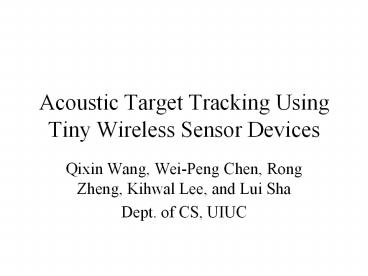Acoustic Target Tracking Using Tiny Wireless Sensor Devices - PowerPoint PPT Presentation
Title:
Acoustic Target Tracking Using Tiny Wireless Sensor Devices
Description:
Acoustic Target Tracking Using Tiny Wireless Sensor Devices ... Tiny wireless sensors to real-world acoustic tracking applications. ... – PowerPoint PPT presentation
Number of Views:102
Avg rating:3.0/5.0
Title: Acoustic Target Tracking Using Tiny Wireless Sensor Devices
1
Acoustic Target Tracking Using Tiny Wireless
Sensor Devices
- Qixin Wang, Wei-Peng Chen, Rong Zheng, Kihwal
Lee, and Lui Sha - Dept. of CS, UIUC
2
Introduction
- Context
- Delay based sound source locating algorithm,
requires large number of redundant sensors for
accuracy. - -Tiny wireless sensors to real-world acoustic
tracking applications. - Tracking only impulsive acoustic signals, such as
foot steps, sniper shots etc. No concept of
tracking motion.
3
Introduction
- Challenges
- Partial info at one sensor site
- Inaccuracy and unreliability of sensors
- Effective use of scarce wireless bandwidth
- Solutions
- Sensor clustering and coordination
- Redundancy for robustness
- Quality-driven (QDR) networking. Info. flow
oriented v.s. raw data flow oriented.
4
Introduction
Scenario
Sensor
Router
Cluster Head
Sink/Pursuer
Cluster Head
Sink/ Pursuer
5
System Overview
- System Architecture
- Acoustic target tracking subsystem
Sensor (mica motes)
Sensors belong to clusters with singular cluster
head. Cluster head knows the locations of its
slave sensors. Raw data gathered from sensors are
processed in cluster head to generate
localization results
Cluster Head (mono-board computer)
6
System Overview
- Communication Subsystem route back the reports
generated by cluster heads to sink
Sink
cluster covered area
cluster head
router (mica motes)
7
Acoustic Target Tracking Subsystem
- Use RBS Time Synch (error ? 30?s).
- Onset Detection (on sensors)
- Small sliding window to compute moving average of
acoustic signal magnitude. - Use threshold to detect onset time t0.
- Record one buffer load of data, then
post-process.
8
Acoustic Target Tracking Subsystem
- Cross Correlation (to find out delays)
Locate sound src loc.
Detected intersted sound
Broadcast sound signature
ClusterHead
Cross-correlation to detect local arrival time
Report local arrival time
SlaveSensor
9
Acoustic Target Tracking Subsystem
- Sound Source Locating Evaluation of Quality
Rank (main idea) - Throw away apparently erroneous sensor readings.
- Let A clusters monitored area, sound src
location arg?p?Amind(p) - ds,where d(p)
is the hypothetical sensors sound arrival time
vector, while ds is the actual one. is an
error measurement function.
10
Acoustic Target Tracking Subsystem
- In practice, we cannot check every location in A,
instead, we apply a grid with 3?3inch2
granularity onto A, and only check those grid
points. - Quality Rank percentage of d(p)s elements that
falls outside ? boundary of ds .
11
Communication Subsystem
- Quality-driven(QDR) Redundancy Suppression and
Contention Resolution - Redundant clusters may report same events
location. Good for reliability reasons. - Quality Rank is used to suppress inferior reports
and only report high quality rank localization
reports to data sink
12
Acoustic Target Tracking Subsystem
- Quality Rank is also used for contention
resolution along the routes (with CSMA as MAC) to
let higher quality reports get to data sink
earlierTbackoff QualityRank ? interval
random
13
Experiment
- Locations of sensors and sound sources in a
single cluster
14
Experiment
- Examples of localization results for different
sound source locations
15
Experiment
- Average error vs. sound source locations. Note
sound source is a 4inch speaker
16
Experiment
17
Experiment
- of reports within 3-inch error range higher
quality rank, higher creditabi-lity
18
Experiment
- Quality-driven (QDR) Effect of various interval
on the percen-tage of suppressed reports
19
Experiment
- Effect of Quality-driven(QDR)
Suppose info/bit is fixed the smaller Quality
Rank, the better the quality.
20
Conclusion
- Acoustic target tracking using tiny wireless
devices with satisfying accuracy is possible. - Quality Rank can be used to decide the quality of
tracking result - Quality-driven redundancy suppression and
contention resolution is effective in improving
the information throughput.































